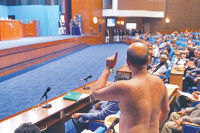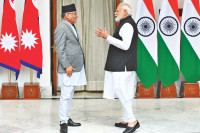Special Supplement
Yearender 2023: Have borrowed words enriched Nepali literature?
For contemporary writers, the key is to choose words that resonate well with the readers, creating a harmonious blend of languages in Nepali literature.%20(1).jpg&w=900&height=601)
Anish Ghimire
The evolving landscape of Nepali literature, marked by the infusion of English words, continues to be a subject of exploration and debate. A good example would be Nepali language writers using the English word—surprised—while there is already a Nepali word—चकित—to describe the same emotion.
The question, therefore, is—is Nepali literature, which has always been deeply rooted in the nation’s rich cultural legacy, currently caught between tradition and modernisation? Or are Nepali writers getting caught in the undercurrent of native writers using ‘loanwords’, mostly English, in their writings for various reasons but most importantly because English is a more versatile language and considered the global tongue given its wide usage in today’s world?
Contemporary Nepali writers like Subin Bhattarai and Krishna Kusum have their reasons to support the usage of borrowed words, wherein they both agree that such a practice helps their readers relate to their works.
Bhattarai, the author of the novels ‘Summer Love’, ‘Saya’ and ‘Priya Sufi’ supports the idea of mixing English words into Nepali literature because he wants the writing to “sound like how people naturally speak.” He believes that by doing this, the language in stories can capture the rhythm and flow of everyday conversations. “In our daily lives, we easily use both English and Nepali while talking. I want my writing to reflect this ease of blending languages,” he says.
The simplicity Bhattarai encourages is about making things easy for everyone to understand. A staunch believer in keeping language accessible, he wants his writing to be clear, straightforward and easily understood. “I suggest using only a few English words here and there, seamlessly integrating them into sentences,” he says.
Bhattarai’s support for incorporating words from other languages into Nepali literature goes beyond just the English language. If one can use the intended meaning of the words in any language effectively, he encourages the use of such borrowed words. For him, the key is to choose words that resonate well with the readers, creating a harmonious blend of languages in Nepali literature.
Krishna Kusum, the writer of the story collection ‘Parshawdhun’, is also a proponent of blending languages to experience the magic of prose. He underscores the simplicity and clarity that certain English words bring to Nepali literature, which Nepali words fail to convey. His perspective aligns with the idea that using English words selectively can make the overall meaning more accessible and comprehensible to a wide audience.
Kusum incorporates English words in his writing to gain clarity. “I believe in using English words since they serve as a bridge, helping readers easily grasp the intended meaning,” he said. “The selective use of English words becomes a tool for breaking down linguistic barriers, making the literature more inclusive and relatable.”
Linguist Ramesh Shrestha, recipient of the Fulbright-Hays scholarship for studying Linguistics at Michigan State University, East Lansing, says the inclusion of English words is a reflection of the current trend. In saying so, he points to a prevalent practice among Nepali speakers who liberally integrate English words and phrases into their daily conversations.
In Shrestha’s analysis, the idea of a ‘colonial hangover’ emerges, highlighting the historical foundations ingrained in Nepal’s educational system. While Nepal was not colonised by the British, the Indian education system whose foundation was laid during the British rule in India, did spill over to the Nepali education system, says Shrestha.
“In the 1950s, the Indian/Patna syllabus was mainly followed in Nepal’s school curriculum. Given this historical context, the use of English vocabulary in Nepali literature may be a legacy of the colonial era’s educational system,” Shrestha told the Post.
Moreover, Shrestha delves into the contemporary psyche of the Nepali population, proposing that the current trend is an attempt by the Nepali mind to connect with the global language—English. He identifies English as the global lingua franca, a language commonly used for communication between speakers of different native languages.
Meanwhile, Chandra Gurung, known for his literary works such as ‘Usko Mutu Vitra Desh Ko Naksha Nai Thyena’, ‘My Father’s Face’, and ‘Jaba Euta Manche Haraucha’, believes that the use of borrowed words in Nepali literature dilutes the Nepali language and puts the national language at risk of corruption.

Gurung is dedicated to preserving the national language. He views literature as a significant vehicle for this purpose. He emphasises that one of the fundamental roles of literary works should be to contribute to the richness and vitality of the language. According to Gurung, the overuse of foreign words, particularly English, does not align with this objective and may even hinder the preservation of the linguistic heritage.
He urges Nepali writers to limit the use of English words in Nepali literature.
“The use of English words liberally compromises the elegance of Nepali literature,” he says. “The responsibility of preserving the Nepali language lies with contemporary and future writers. We must focus on nurturing an appreciation for the national language among readers, particularly the younger ones.”
Writer and lyricist Janu Kambang Limbu says the integration of English into Nepali literature represents a natural evolution in response to the changing times. Limbu published a poetry collection ‘Shivirma Ishwar’, in 2015 and a story collection ‘Naughreko Jun’, in 2018. She views language as a dynamic entity that must adapt to the evolving communication styles of its speakers. Unlike Gurung, in her perspective, if people commonly speak by blending English and Nepali, there’s no reason why writing shouldn’t reflect the same linguistic fusion.
Limbu goes on to refer to the English words incorporated into Nepali as “guest words”, highlighting their role in enriching and enhancing the expressive capacity of Nepali writing. She sees these borrowed words as valuable additions that contribute to the overall vibrancy and diversity of the language. She also acknowledges the impact of globalisation on linguistic patterns and advocates for literature to mirror the contemporary use of language.
In the changing times, people’s reading habits have evolved. Nirmal Kumar Thapa, the founder of Color Nepal Publication, says, “In the past, people used to read Sanskrit and Nepali. Nowadays, Nepali and English are the languages of choice.”
Thapa argues that many writers today use English words because some expressions are easier to convey in English than in Nepali. Through his interactions with numerous writers and his reading of upcoming books through his publication, he implies that modern writers frequently adapt to the usage of language.
“We had writers like Maha Kavi Laxmi Prasad Devkota and essayist Shankar Lamichhane who are remembered for their rich vocabulary in Nepali,” says Thapa. “They consciously avoided using English words. These literary figures are examples of those who maintained the purity and richness of the Nepali language in their work. However, with the changing literary scene world over, the use of borrowed words in Nepali literature does not pose a threat to the Nepali language.”




 5.47°C Kathmandu
5.47°C Kathmandu










